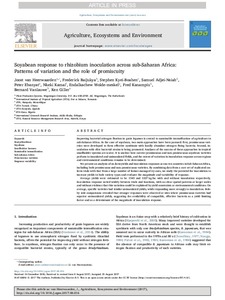| dc.contributor.author | Heerwaarden, Joost van |
| dc.contributor.author | Baijukya, Frederick P. |
| dc.contributor.author | Kyei-Boahen, S. |
| dc.contributor.author | Adjei-Nsiah, Samuel |
| dc.contributor.author | Ebanyat, Peter |
| dc.contributor.author | Kamai, N. |
| dc.contributor.author | Woldemeskel, Endalkachew |
| dc.contributor.author | Kanampiu, F. |
| dc.contributor.author | Vanlauwe, Bernard |
| dc.contributor.author | Giller, Ken E. |
| dc.date.accessioned | 2019-12-04T11:10:28Z |
| dc.date.available | 2019-12-04T11:10:28Z |
| dc.date.issued | 2018 |
| dc.identifier.citation | van Heerwaarden, J., Baijukya, F., Kyei-Boahen, S., Adjei-Nsiah, S., Ebanyat, P., Kamai, N., ... & Giller, K. (2018). Soyabean response to rhizobium inoculation across sub-Saharan Africa: patterns of variation and the role of promiscuity. Agriculture, Ecosystems & Environment, 261, 211-218. |
| dc.identifier.issn | 0167-8809 |
| dc.identifier.uri | https://hdl.handle.net/20.500.12478/2155 |
| dc.description | Article purchased; Published online: 7 Sept 2017 |
| dc.description.abstract | Improving bacterial nitrogen fixation in grain legumes is central to sustainable intensification of agriculture in sub-Saharan Africa. In the case of soyabean, two main approaches have been pursued: first, promiscuous varieties were developed to form effective symbiosis with locally abundant nitrogen fixing bacteria. Second, inoculation with elite bacterial strains is being promoted. Analyses of the success of these approaches in tropical smallholder systems are scarce. It is unclear how current promiscuous and non-promiscuous soyabean varieties perform in inoculated and uninoculated fields, and the extent of variation in inoculation response across regions and environmental conditions remains to be determined.
We present an analysis of on-farm yields and inoculation responses across ten countries in Sub Saharan Africa, including both promiscuous and non-promiscuous varieties. By combining data from a core set of replicated on-farm trials with that from a large number of farmer-managed try-outs, we study the potential for inoculation to increase yields in both variety types and evaluate the magnitude and variability of response.
Average yields were estimated to be 1343 and 1227 kg/ha with and without inoculation respectively. Inoculation response varied widely between trials and locations, with no clear spatial patterns at larger scales and without evidence that this variation could be explained by yield constraints or environmental conditions. On average, specific varieties had similar uninoculated yields, while responding more strongly to inoculation. Side-by side comparisons revealed that stronger responses were observed at sites where promiscuous varieties had superior uninoculated yields, suggesting the availability of compatible, effective bacteria as a yield limiting factor and as a determinant of the magnitude of inoculation response. |
| dc.description.sponsorship | Bill & Melinda Gates Foundation |
| dc.format.extent | 1-8 |
| dc.language.iso | en |
| dc.subject | Bradyrhizobium |
| dc.subject | Soybeans |
| dc.subject | Farmers |
| dc.subject | Sustainable Agriculture |
| dc.subject | Intensification |
| dc.subject | Varieties |
| dc.subject | Grain Legumes |
| dc.title | Soyabean response to rhizobium inoculation across sub-Saharan Africa: Patterns of variation and the role of promiscuity |
| dc.type | Journal Article |
| dc.description.version | Peer Review |
| cg.contributor.crp | Grain Legumes |
| cg.contributor.crp | Integrated Systems for the Humid Tropics |
| cg.contributor.crp | Water, Land and Ecosystems |
| cg.contributor.affiliation | Wageningen University and Research Centre |
| cg.contributor.affiliation | International Institute of Tropical Agriculture |
| cg.contributor.affiliation | International Livestock Research Institute |
| cg.coverage.region | Africa |
| cg.coverage.region | Central Africa |
| cg.coverage.region | East Africa |
| cg.coverage.region | Southern Africa |
| cg.coverage.region | West Africa |
| cg.coverage.country | Congo, Dr |
| cg.coverage.country | Ethiopia |
| cg.coverage.country | Ghana |
| cg.coverage.country | Kenya |
| cg.coverage.country | Malawi |
| cg.coverage.country | Mozambique |
| cg.coverage.country | Nigeria |
| cg.coverage.country | Rwanda |
| cg.coverage.country | Uganda |
| cg.coverage.country | Zimbabwe |
| cg.isijournal | ISI Journal |
| cg.authorship.types | CGIAR and advanced research institute |
| cg.iitasubject | Grain Legumes |
| cg.iitasubject | Soybean |
| cg.journal | Agriculture, Ecosystems & Environment |
| cg.howpublished | Formally Published |
| cg.accessibilitystatus | Open Access |
| local.dspaceid | 90798 |
| cg.targetaudience | Scientists |
| cg.identifier.doi | http://dx.doi.org/10.1016/j.agee.2017.08.016 |

